1964 Monaco Grand Prix race report: Lotus fails where Hill prevails
Jim Clark's Lotus goes to pieces - quite literally - allowing Graham Hill to sail to his second Monaco victory

Hill took his second win on the streets of Monaco
Motorsport Images
Being the first of the Grand Prix classics for 1964 all the leading teams had hopes of fielding their latest cars all ready, tried and proven, but in fact only BRM and Brabham were in this happy state of affairs. The Bourne team had their two 1964 cars, with stressed-skin chassis, simplified front suspension with inboard-mounted coil springs, compressed by rocker-arm top wishbones, rear suspension with single top transverse strut and twin radius arms and lower wishbones, with external coil spring units, all very simple and Lotus or Brabham like in layout, while the engines were the usual V8-cylinder units with Lucas fuel injection, and the drivers were Graham Hill and Richie Ginther, the latter now recovered from his Aintree practice crash.
Brabham and Gurney had the two 1964 works Brabham cars, with Climax V8 engines and Hewland 5-speed gearboxes, and both were using 13 in. wheels with the latest wide-tread Dunlop tyres. Brabham’s car was using a new type of solid drive shaft with “bungy ring” universal joints, while Gurney’s car was using the old-fashioned Hardy Spicer splined shafts, though later they were changed for the new pattern shafts. The Cooper team had two 1964 cars for McLaren and Phil Hill, though the American driver’s car was so new that it had yet to turn a wheel.
These cars follow the pattern of the Type 72 Formula Three cars, with tubular space frame strengthened by welded-on sheet steel panels, with rocker-arm front suspension and single radius arm rear suspension with lower wishbones and transverse struts, coil springs being used all round. The engines remain Climax V8 units and Cooper gearboxes are used, while both cars were on the latest 13in diameter tyres. They had their 1963 car as a spare.
The Ferrari team of Surtees and Bandini had the three cars they had taken to Siracusa, with little or no development changes as the factory is busy with Le Mans prototype cars. There is still only one V8 car and Surtees had this, Bandini having a 6-cylinder car and the other 6-cylinder being a spare; the experimental Marelli electronic ignition tried on the spare 6-cylinder car at Siracusa was replaced by normal Bosch coil ignition, as used on the other cars, with alternators to keep the batteries charged.
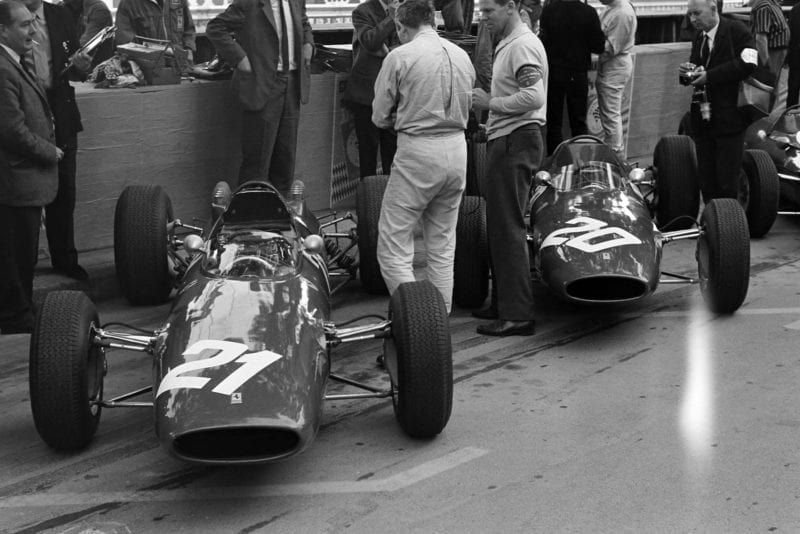
Ferrari took three cars to the Grand Prix
Motorsport Images
Team Lotus were almost back to where they started the season, for Clark’s crash at Aintree had destroyed the new Type 33 chassis and new ones were not ready, so the two 1963 cars, modified to Type 25B, were used. Both were now fitted with the latest ZF gearboxes and revised gear lever and linkage, and Clark’s car not only had 13in tyres but also the rear suspension off the Type 33 and the solid steel steering arms from that design and a new and stronger design of drive shaft, while Arundell’s car still had 1963 suspension but was about to be modified to take 13in wheels, and retained 1963 drive shafts.
The main difference with the Type 33 is that the wheelbase is 1in longer to accommodate the latest Climax V8 engine more easily, and this together with the 13in wheels has necessitated detail redesigning of the suspension geometry, but ostensibly the Type 33 when it reappears again will be like the Type 25. One could say that Arundell’s car had become a 25C, with 1964 wheels, uprights and gearbox, and Clark’s car was a 25D, with 1964 wheels, uprights, gearbox drive shafts and rear suspension mods., and they both had the latest Coventry-Climax V8 engines. On the 25D the top rear radius arm is attached to the hub carrier at the same point as the transverse link, whereas on the 25C it is attached nearer to hub centre level, this being a matter of geometry and wheel movement.
The BRP team were in a similar sad state to Lotus, for Ireland had crashed the Mk II BRP monocoque at Silverstone and had bent the chassis beyond repair. Consequently, Ireland had the old Lotus 24 with BRM V8 engine and Colotti gearbox, while Trevor Taylor had the Mk I BRP monocoque with similar engine and BRM 6-speed gearbox.
The rest of the entry consisted of private owners, Amon and Hailwood with the Parnell-built Lotus 25-BRM V8 cars, Anderson with his new 1964 Brabham with V8 Climax engine on Weber carburetters, and 5-speed Hewland gearbox, Bonnier with Rob Walker’s 1963 Cooper-Climax V8, his new Brabham-BRM V8 having been burnt at Silverstone, Trintignant with his recently-acquired BRM V8, it being the one Attwood drove at Goodwood, but now painted pale blue, and Revson (Lotus-BRM V8), Collomb (Lotus-Climax V8) and Siffert (Lotus-BRM V8), non-starters being Pilette (Scirocco-Climax V8) and the two Centro-Sud BRM V8 cars that Baghetti and Maggs should have driven but a shortage of skilled mechanics prevented them being prepared in time.
Qualifying
Practice began on Thursday after lunch and went on for an hour and a half in glorious-sunshine and Clark and Gurney were missing, being on their way back from practice at Indianapolis, though their cars were ready just in case they should arrive. Arundell did some laps in Clark’s car on 13in wheels and recorded an identical time to that done with his own car, as yet on 15in wheels, but Brabham only did a few quiet laps in Gurney’s car to see that everything worked all right. His fast laps he did in his own car and was soon in a split-second dice with Surtees in the Ferrari V8, battling for the fastest time of the day, which Surtees eventually got by one tenth of a second, though all the while Graham Hill was in the running and was finally only two tenths of a second behind Brabham.
Not having been used since the Monte Carlo Rally the circuit was very dusty and clouds of cement dust were blown up along the harbour front as the cars went by, so that times were fast but not record-breaking. Ireland began to go fast but was delayed by brake trouble and he was feeling a bit knocked about having crashed at Silverstone the previous Saturday and the day before this practice session he had been involved in a road accident and damaged his knee. The brake fault on the Lotus corrected, he went off again but had not been gone long before he arrived at the chicane going much too fast, with a locked rear wheel, and struck a corner post on the left. The Lotus flew through the air and was badly wrecked and Ireland staggered away with more bruises, being very lucky to get away with it. As practice finished Clark arrived, but too late to take part and not very happy at having gone all the way to Indianapolis and not even having sat in the Lotus-Ford V8, as it was not ready for practice.
Next morning practice took place at 8am while the sun was still trying to break through some thin cloud, so conditions were ideal and Clark was at the head of the queue and was first away, with Surtees just behind and Gurney also an early starter. Ginther’s BRM had been brought into line with Hill’s, having 13in wheels now.
In yesterday’s practice it had been quite a while before anyone had got below 1min 40sec, and eventually Surtees had finished up at 1min 35sec with the V8 Ferrari, compared to his 1963 race lap record of 1min 34.5sec with the old spaceframe V6 Ferrari. In practice last year Clark had got down to 1min 34.3sec and he hadn’t done many laps this particular morning before he was below 1min 40sec and this got everyone else into the groove.
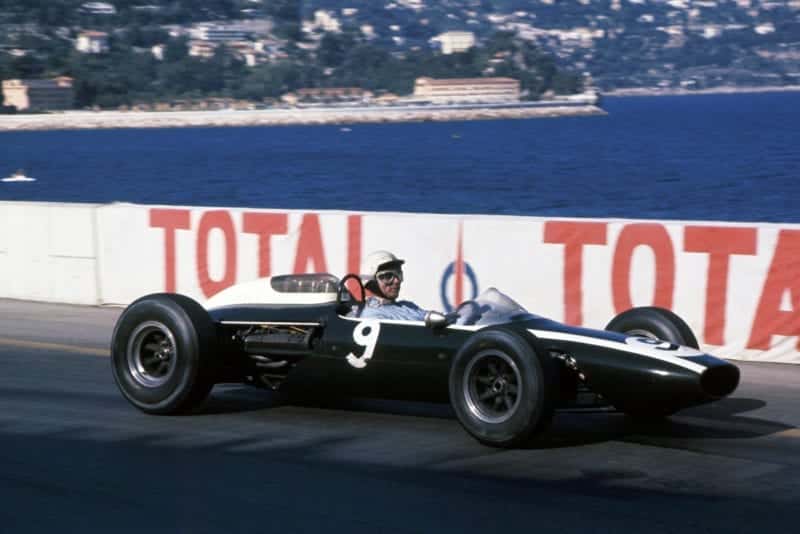
Phil Hill showed promising early pace in the Cooper
Motorsport Images
Phil Hill was in great form and did 1min 36.7sec but Bandini beat this with 1min 36.3sec, even though the 6-cylinder Ferrari was understeering badly across the Casino square, Surtees was not at all happy with the V8 Ferrari and finally gave up with gearbox bothers and went out in the spare V6 car. Phil Hill now did 1min 36sec, being very happy to be in a car that really went instead of having to keep stopping as he had done last year, and he was really standing on the throttle out of the Casino square and down the hill to the station.
Clark tried Arundell’s car with the 15in wheels and was lapping in 1min 37sec but Brabham was under way and, with fists clenched tightly on the steering wheel and a fair amount of opposite lock, he got down to 1min 35.7sec, but then Clark in Arundell’s car set a new fastest time with 1min 35.5sec and then stopped and changed over to his own car, on 13in wheels, and did 1min 34.7sec.
Hailwood now got his feet slightly mixed up on the pedals (it only needs a split-second error on the Monaco circuit to get you into trouble) and he clouted a wall with the Lotus 25, bending the front but not hurting himself. There was now a great deal of high-speed traffic out on the circuit and Gurney, Bandini, Graham Hill, Brabham and Clark all went charging through the Casino square as if they really meant business; they obviously did for Gurney got down to 1min 34.7sec, Bandini to 1min 35.5sec, Hill to 1min 34.8sec, Brabham to 1min 34.6sec and Clark to 1min 34.1sec, and then they all stopped for a breather with Clark holding ftd.
Although the regulations said that only 16 of the entry could start and these would be on practice times, this charging about was to get a front row grid position, which is always much more important than just qualifying. As 9am approached the sun began to shine and everyone went for a final fling. McLaren came to an abrupt halt before the Casino bend when his right-hand steering arm broke, this being one of the new cast electron variety, and Gurney disappeared down to the station hairpin with smoke pouring out of the back of his Brabham, and did not come round again, but Brabham had a last go and equalled Clark’s time of 1min 34.3sec but the wily Scot was even then clocking 1min 34sec to take ftd and fastest ever on the Monaco circuit.
On Saturday there was another hour of practice after there had been two short F3 races and Surtees had the V8 Ferrari repaired, McLaren was using the 1963 Cooper, Phil Hill’s 1964 Cooper had steel “Safety keeps” on the cast steering arms in case he suffered a breakage, Arundell was without a car as it was being converted to take 13in wheels and the job was taking longer than expected, and the Parnell mechanics had done a first-class job of repairing Hailwood’s Lotus monocoque, riveting a steel gusset plate into the left front corner, and remaking the wishbone pivot points.
With three non-starters and Ireland’s car wrecked there were only 19 competitors left to contest the 16 starting positions and all the works drivers were already well up the list, so this final session was only tense for the private-owners at the back of the field and Clark showed Collomb the way round when practice started, but although he improved slightly he hadn’t a hope of qualifying. It is interesting that Collomb’s best time was 1min 41.4sec, a whole second quicker than Fangio’s lap record in 1955 with the W196 Mercedes-Benz, yet it was nowhere near fast enough to qualify to start in this year’s race, such is the march of progress.
Anderson, one of the few private drivers who really owns his own car, did extremely well to qualify with a time of 1min 38sec, ahead of Trintignant, Taylor, Hailwood and Siffert, in fact he was the fastest of the “owner-drivers” if you exclude Brabham, whereas Amon was disappointing and failed to qualify along with Revson and Collomb. The battle for front row positions still went on but no-one approached the times of Clark and Brabham set up the day before, but Graham Hill and Surtees both ousted Gurney from the second row with equal times of 1min 34.5sec.
Race
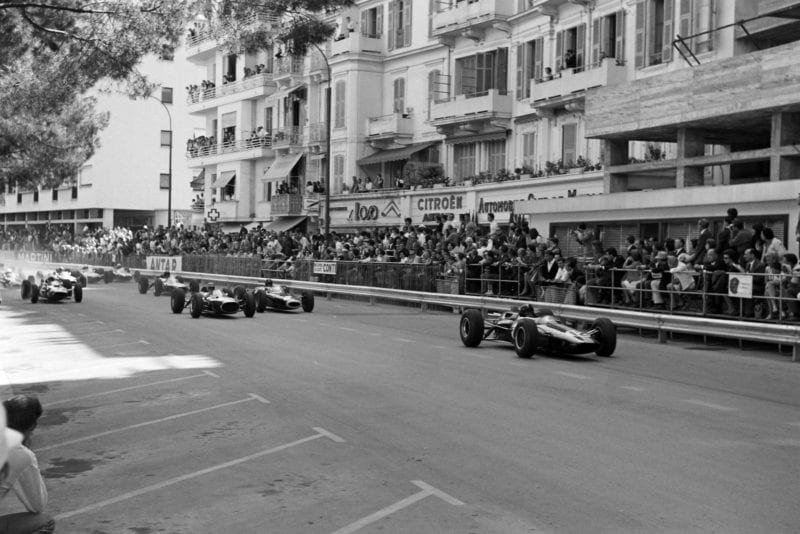
Clark leads the field at the start
Motorsport Images
On Sunday after Prince Rainier and Princess Grace of Monaco had opened the circuit by driving round in a 2.6-litre Alfa Romeo Spyder the 16 starters were lined up in pairs, each pair being slightly offset to that in front. At approximately 3:15pm engines were started behind the actual grid and when everyone was ready they rolled gently forward onto their allotted positions, the flag was raised and as it came down the whole field got away cleanly for the 100 laps of the Monaco circuit, though Taylor’s BRP was dripping petrol from a leak in a tank.
Even by the first corner Clark had got the lead and his opening lap was meteoric, so much so that he overdid it at the exit from the chicane and bounced violently off the straw bales, but caught it and carried on at unabated speed. Behind him Brabham was leading Graham Hill, Gurney, Surtees and Gunther in a nose-to-tail struggling pack and this group had already left the rest of the runners behind. Two separate races had developed even in the opening lap, there was the group trying to keep up with the flying Clark and the remainder being led by McLaren with most of the second-string works drivers behind him with the private-owners bringing up the rear.
“Clark’s opening lap was meteoric, so much so that he overdid it at the exit from the chicane and bounced violently off the straw bales”
For ten laps the order of the leading group was unchanged, except that Clark was further ahead than ever, and Ginther was not quite keeping up the pace of the big-boys. Gurney was making signs of trying to get past Graham Hill and on lap 12 he did this and immediately went past Brabham as well and, looking very grim and determined, he reduced Clark’s lead by a second or two, but no more. On this lap Surtees was in real trouble with his gearbox and had dropped behind Gunther, while Taylor had already retired and Siffert was in the pits with trouble in his hydraulic clutch operating mechanism, but continued later.
Surtees made a brief pit stop, rejoined the race behind Bandini but was soon back again in the pits to retire with gearbox trouble. In the second group of cars Phil Hill had begun to get into his stride and he overtook Bandini, Arundell and then McLaren but had no hope of mixing with the leaders. McLaren’s car was blowing out a lot of oil smoke as the rear main bearing was passing oil and by lap 18 he was out of the race and Arundell was down amongst the private-owners, as apart from never having driven his car on 13in wheels until the race started he was also having all sorts of niggling little discomforts such as suspect brakes and gearchange, and an uncomfortable seat.
By lap 20 the pace was still very fast and the leading trio were lapping at just over 1min 36sec but the situation was constant, with Clark 6sec ahead of Gurney, but not gaining any more, and Graham Hill holding on close to Gurney. A slight gap had opened up before Brabham arrived, with Ginther just behind him, but the Australian’s Climax engine was going off song due to something wrong in the fuel-injection system.
As Clark rounded the gasworks hairpin on lap 23 his rear anti-roll bar could be seen broken away from its mountings, though he had undoubtedly lost the benefit of it some laps before but had adjusted his driving to the altered handling characteristics. It made no difference to his pace and, in fact, he speeded up, just to convince everyone that all was well and by lap 30 he had 10.5sec lead over Gurney while Graham Hill was still keeping his BRM in the Brabham’s slip-stream.
Brabham himself was losing power consistently now and after Ginther had passed him he retired at the pits rather than risk blowing up the engine. It seems the timing of the fuel injectors was getting out of phase, trouble he had experienced during practice. The order now was Clark (Lotus), Gurney (Brabham), Hill (BRM), Ginther (BRM), Hill (Cooper), Bandini (Ferrari), Arundell (Lotus), Trintignant (BRM), Bonnier (Cooper), Anderson (Brabham), Hailwood (Lotus), and Siffert (Lotus), there already being four retirements, and all behind Bandini had been lapped by the leaders.
While the organisers were considering whether to black-flag Clark and have the trailing anti-roll bar removed, Chapman was deciding to call him in anyway, but most of it broke off and slid harmlessly out of the way after he had been flagged in, so that when he stopped at the pits on lap 37 there was only one link to remove. However, this took long enough for Gurney and Hill to go by and Clark restarted with them disappearing round Ste Devote corner.
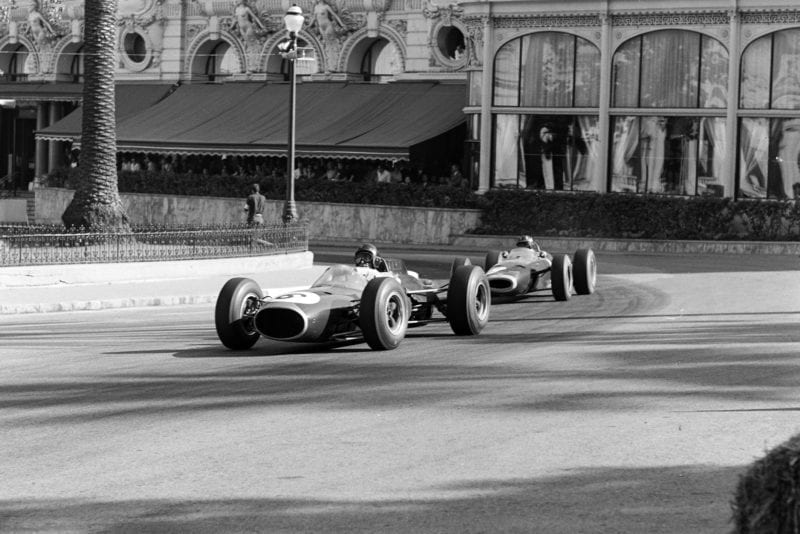
Gurney leads Hill through Casino
Motorsport Images
Now the situation was really interesting for Gurney was not hanging about and had 3sec lead on Graham Hill and Clark was a further 3.5sec behind, but using all that the Lotus-Climax could give. Yard by yard he was closing the gap, but Hill was putting on the pressure as well and by lap 40 he was almost touching Gurney on the slow corners while Clark was nearly with them and had lapped at 1min 34sec, a new record. Everyone else except Ginther had been lapped and Phil Hill’s Cooper was showing signs of overheating so that he was forced to ease up a little and Bandini was catching him.
At 50 laps, which was half-distance, Gurney was still holding a precarious lead from Hill who obviously had ideas about getting in front now, for Clark was right behind the BRM and less than 2sec covered the first three cars. Ginther was a lonely fourth and a lap behind came Phil Hill, Bandini and Arundell, and two laps behind Bonnier, Anderson, Hailwood, Trintignant and Siffert. The veteran French driver had dropped back due to overheating and was suffering from scorched feet and was shortly to have to give up.
“Gurney was still holding a precarious lead from Hill who obviously had ideas about getting in front”
At the end of lap 52 Graham Hill was clearly lining himself up to pass Gurney and thus foil Clark who was looking for an opening to pass them both and as they came down to the station on lap 51 the BRM took the lead and that little effort resulted in a new lap record for Hill in 1min 33.9sec. The battle now eased slightly and it looked as though the leading trio were going to sit it out and make an endurance race of the situation though Clark kept looking for an opportunity to get by Gurney, but before he could do so the Hewland gearbox on the Brabham gave out and Gurney coasted into the pits to retire on lap 62.
Ginther had been lapped by his number one so now there was only Hill and Clark on the same lap and Bandini had taken fifth place from Phil Hill, but a few laps later Bandini’s gearbox broke (on his 68th lap) and on lap 70, Phil Hill’s rear suspension collapsed. Clark’s Climax engine was showing signs of “fluffing” at peak rpm just as he changed gear and it later transpired that the fuel-injection pump pressure was not as high as it should be and while this did not slow him down visibly it just took the edge off the car’s performance.
Meanwhile Graham Hill’s BRM was going superbly and the gap between him and Clark was now beginning to open up little by little, until it was 10sec at lap 75. The BRM engine sounded as good as ever, as did Ginther’s which was in third position now but a lap behind, whereas Clark’s Coventry-Climax engine was “fluffing” more and more at high rpm and he was having to change gear a bit sooner and it was now blowing out oil smoke.
By lap 80 the issue was settled for the BRM as crisp as ever was 14.5 sec ahead of the Lotus, which by comparison was rough and smoky, but Clark had not given up and was about to lap Arundell for the third time. At 90 laps the gap was still 14.5 sec, but on lap 92 Hill came round on his own, and then Ginther appeared, now in second place, and Clark came coasting along with all his oil pressure gone. There was little or no oil in the system, for what had not leaked out had been burnt and he stopped at the pits to retire before the engine was wrecked.
He was still in third place when he stopped and the leader had only a few more laps to do so Colin Chapman told his driver to go on and try and nurse the car round for a lap or two. Regulations forbade the adding of any more oil so Clark set off again and coasted wherever possible. He was now three laps behind the leading BRM and not far behind Arundell who had taken third place and who was suffering from the same malady of no oil, so no oil pressure.
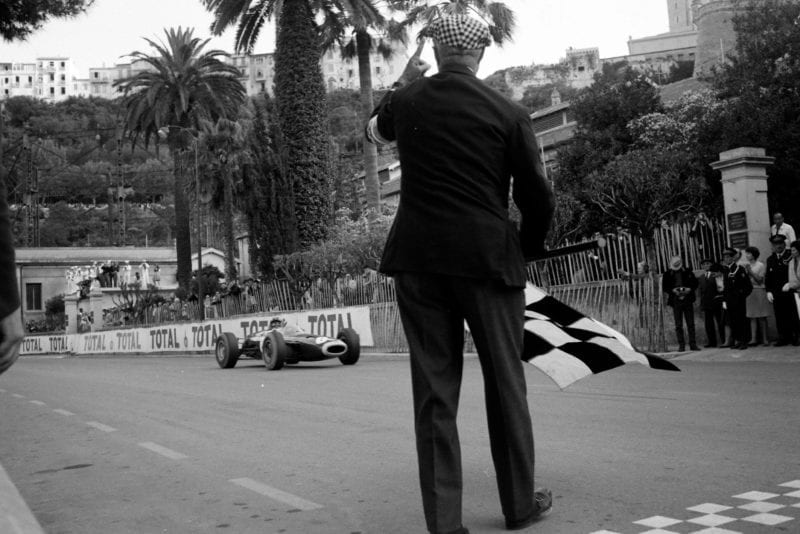
Hill takes the chequered flag
Motorsport Images
As the BRM team received the chequered flag for another magnificent 1st and 2nd, the second year running, Clark’s engine seized up on the climb to the Casino, so he was unable to finish his last lap and Arundell, who had had a comparatively slow and miserable race, took third place. It had been a superb race, where the strength of the machinery had been all-important and BRM engines, BRM gearboxes and BRM chassis had come through without a blemish.
Clark was not the only unfortunate one for Anderson went out on lap 91 when the bolts holding the end cover on his Hewland gearbox worked loose and let all the oil out, causing his retirement. Bonnier and Hailwood were still running at the end, after consistent drives, and Siffert brought up the rear after numerous pit stops for adjustments.
